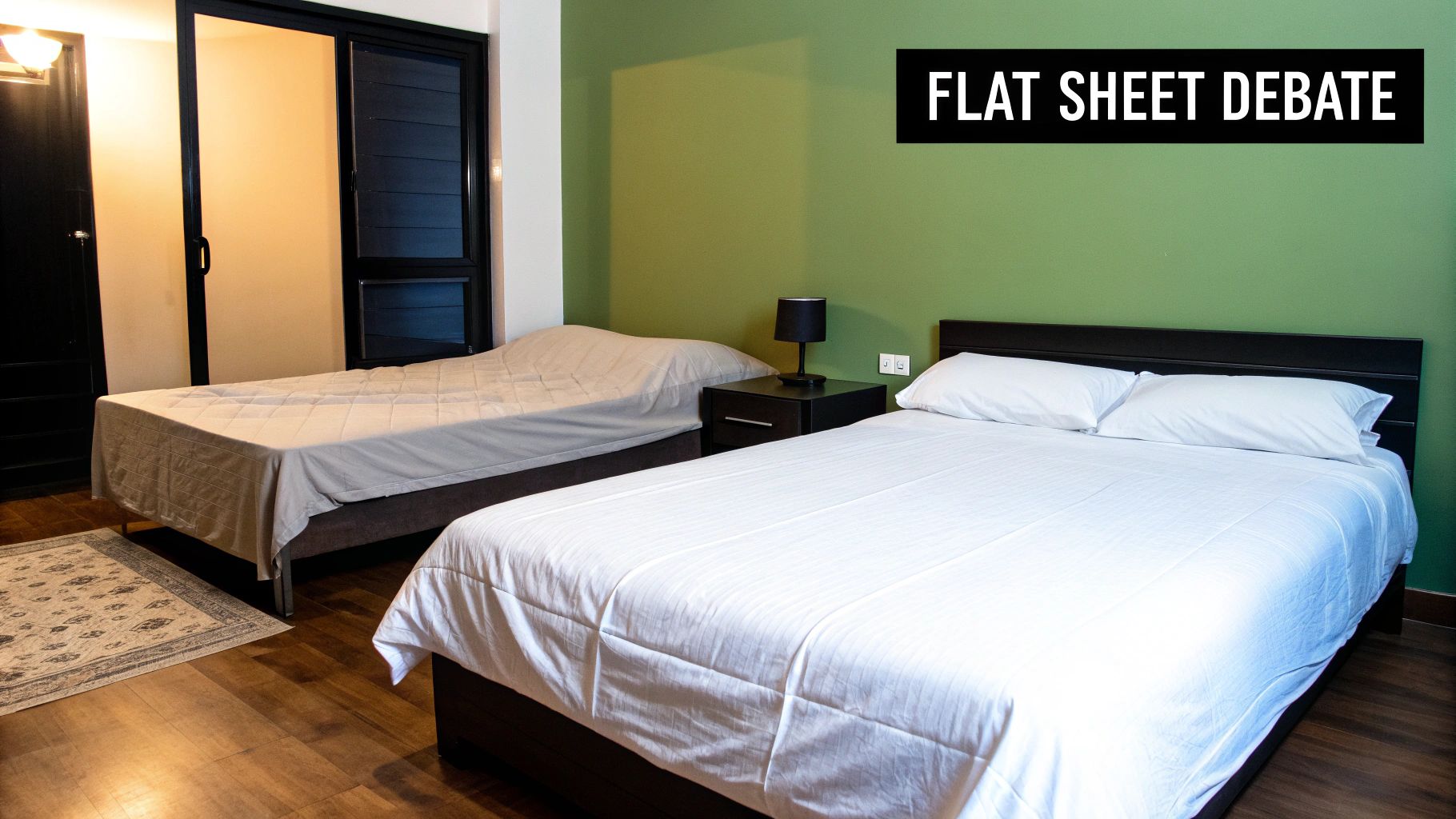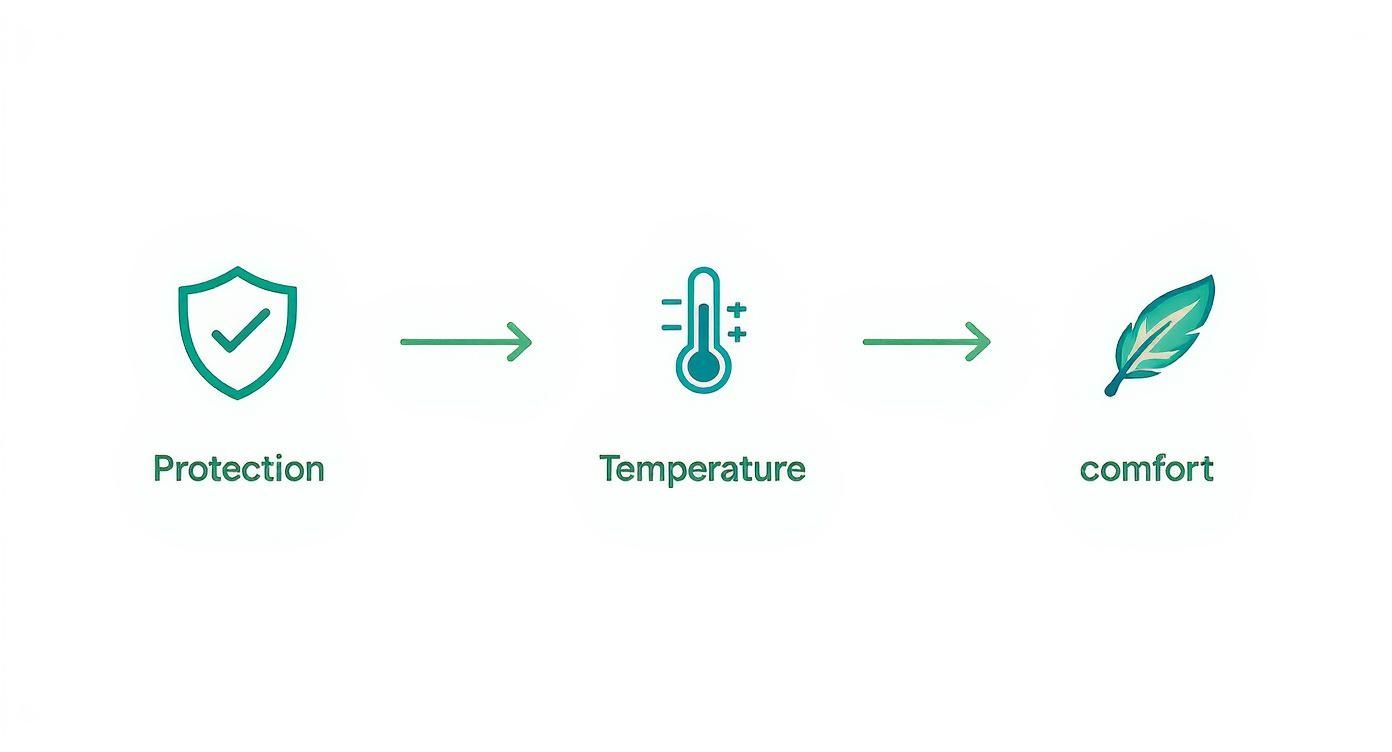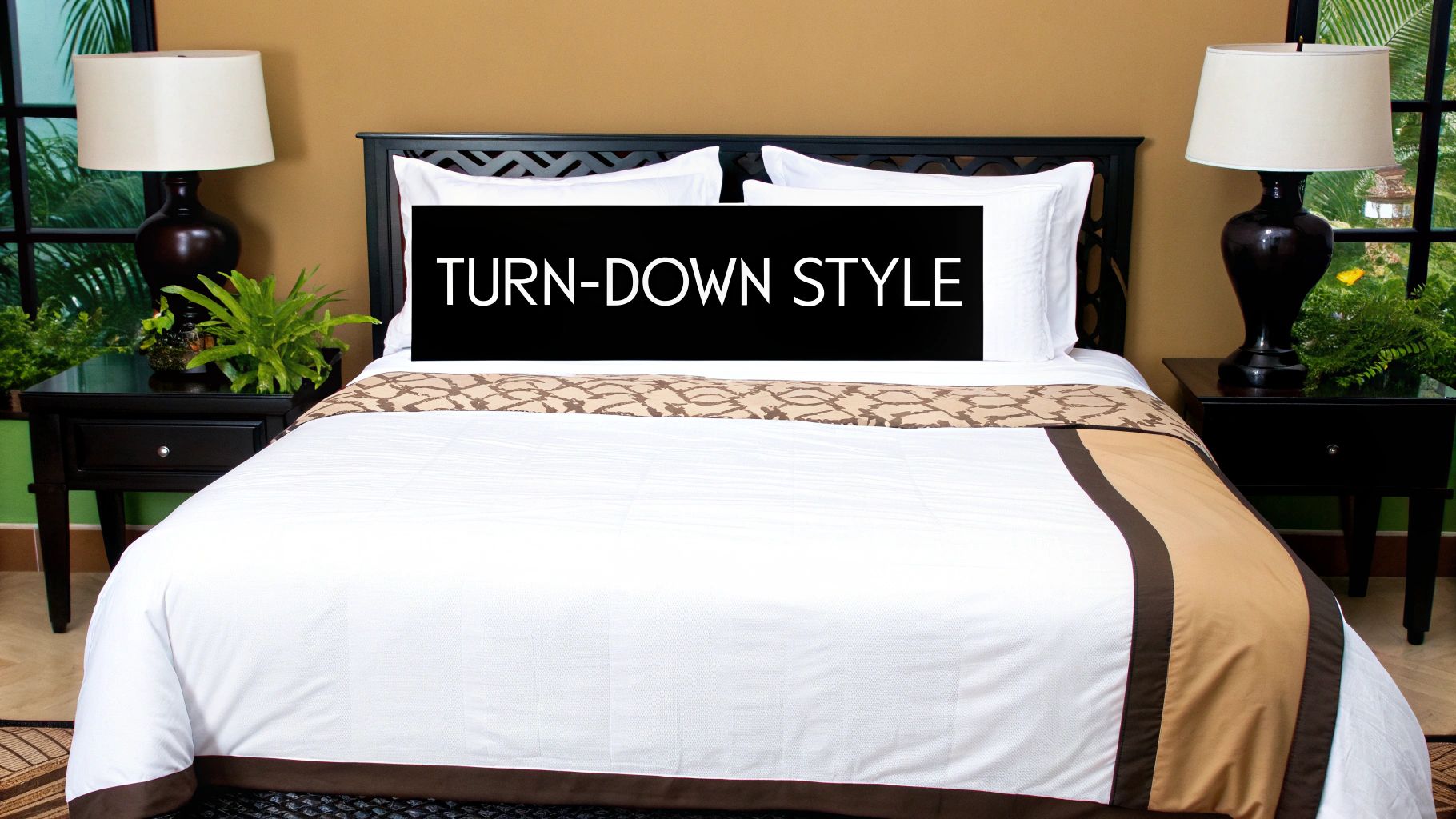At its heart, a flat sheet is just a simple rectangle of fabric that acts as a hygienic, comfortable layer between you and your duvet or blanket. Think of it as a soft, washable shield that keeps your bulkier, harder-to-wash bedding cleaner for longer.
While some people swear by its crisp feel and practicality, others see it as an extra, unnecessary step in making the bed. It's a surprisingly divisive topic.
The Great Flat Sheet Debate Explained

The conversation around the flat sheet, or top sheet as it's often called, is a passionate one. For traditionalists, it’s an essential part of a properly made bed, giving you that clean, hotel-style luxury. It serves as a lightweight cover on warm nights and an extra layer of insulation when it gets chilly.
On the other side of the fence, many modern bed-makers (especially younger generations) have ditched it altogether. They prefer a simplified setup with just a fitted sheet and a duvet in a washable cover, arguing it saves time and effort. After all, doesn't the flat sheet just end up tangled at the foot of the bed anyway?
Ultimately, using a flat sheet comes down to personal preference. There’s no right or wrong answer—only what feels most comfortable and makes your life easier.
Here in Australia, the tradition is still going strong. Surveys suggest around 60% of people still use one every night, though it’s a habit more common among older generations.
To get a clearer picture of where the flat sheet fits in, it helps to understand its primary roles.
Flat Sheet Functions at a Glance
This table breaks down the main jobs a flat sheet does in your bedding setup.
| Primary Use | Key Benefit |
|---|---|
| Hygienic Barrier | Keeps your duvet cover or blanket clean from body oils and sweat, reducing how often you need to wash them. |
| Lightweight Cover | Perfect for hot summer nights when a duvet is too heavy, but you still want something covering you. |
| Extra Insulation | Adds another layer of warmth during winter without adding much weight. |
| Comfort Layer | Creates a soft, smooth barrier between your skin and potentially coarser blanket or quilt textures. |
While it's not essential, it’s clear the flat sheet offers a few practical perks that have kept it in bedrooms for decades.
It's also important not to mix it up with a fitted sheet, as they both have very different jobs. If you're unsure about the difference, check out our guide on fitted vs flat sheets to clear things up. This ongoing debate just goes to show how versatile—but optional—the humble flat sheet has become.
The Three Essential Roles of a Flat Sheet
So, what's a flat sheet actually for, besides being just another layer? It’s stuck around for good reason. Its popularity comes down to three practical jobs it does to make your bed cleaner, comfier, and better suited to you. Once you get what it does, you can decide if it’s right for your sleep setup.
The Washable Duvet Protector
Think of a flat sheet as a bodyguard for your doona. Your quilt or duvet is often bulky and a real pain to wash regularly. The flat sheet slips in between you and your doona, creating a simple, washable barrier that catches all the body oils, sweat, and skin cells you naturally shed overnight.
This means you can just whip the flat sheet off and toss it in the wash with your other bedding each week, while your bulky duvet and its cover stay fresh for much longer. It's a low-effort way to keep your bed more hygienic without wrestling a massive quilt into the washing machine every few days.
Your Personal Climate Control
A flat sheet is a surprisingly good temperature regulator, adapting to whatever the Aussie seasons throw at it. On a sticky summer night, a heavy doona can feel like a trap. A lightweight cotton or linen flat sheet gives you just enough coverage to feel secure without trapping all that heat, letting you sleep cooler.
Then, when a winter cold snap hits, it becomes an extra insulating layer. Tucked between you and your doona, it traps a pocket of air that your body warms up, adding a noticeable amount of cosiness without the weight of another heavy blanket.
The Unmistakable Comfort Factor
Beyond all the practical stuff, a lot of people just love the feeling of a flat sheet. There’s something distinct about slipping into bed and pulling a crisp, cool, clean sheet right up against your skin. For many, that texture is just far nicer than the feel of a standard doona cover.
This preference for that traditional, layered feel is a big part of why flat sheets are still so common. In fact, the sheets and mattress covers segment—which includes flat sheets—made up 42.02% of the total Australian bed linen market in a recent year. That’s a huge slice of a market valued at over $1.4 billion. You can discover more insights about the Australian bed linen market and see how these trends shape what we all sleep on.
The flat sheet offers a unique combination of hygiene, temperature control, and tactile comfort, making it a versatile tool for anyone looking to perfect their sleeping environment.
How to Properly Make a Bed with a Flat Sheet
Getting your flat sheet to stay put doesn't take any special skills, just the right technique. A well-made bed doesn't just look polished and inviting; it stops your layers from ending up in a tangled mess by morning. It all comes down to understanding the layering and mastering a simple tuck.
First, pull your fitted sheet on nice and snug over the mattress corners. Next, lay the flat sheet over the top, making sure the decorative or "finished" side is facing down. This might feel backwards, but it ensures the beautiful side is visible when you fold the top edge down over your doona. Line up the wide top hem with the head of your mattress.
The infographic below shows exactly what a flat sheet does when it's used correctly in your bedding setup.

As you can see, the flat sheet acts as a protective barrier, helps with temperature control, and adds another layer of comfort.
Mastering the Hospital Corner
The secret to a flat sheet that actually stays put is the hospital corner. It’s a neat, tight fold that anchors the sheet, and it’s way easier to do than it sounds.
Here's how you do it:
-
Tuck the End: Start by tucking the entire bottom edge of the flat sheet tightly under the foot of the mattress. Get it really secure.
-
Lift and Tuck: Standing at one side, grab the edge of the sheet about 40cm from the foot of the bed. Lift this section up to create a 45-degree angle with the corner of the mattress. Now, tuck in any fabric that's hanging below this fold.
-
Fold and Smooth: Let the part you lifted drop back down. You'll see a neat, diagonal fold along the side. Tuck this hanging fabric smoothly and firmly under the mattress, working your way up toward the head of the bed.
Repeat on the other side, and you'll have a perfectly crisp and secure bed. For a deeper dive into making your bed look amazing, check out these tips and tricks for a neat and inviting bed to elevate your whole setup. It's a simple routine that can transform your bed from messy to magnificent in just a few minutes each day.
Using a Flat Sheet to Style Your Bed

Beyond just keeping your doona clean, a flat sheet is one of the easiest ways to give your bedroom that professionally styled, designer look. It’s a simple trick that transforms a functional piece of bedding into a key decorative element, giving your bed a polished, hotel-quality finish with almost no effort.
The most common technique is the classic turn-down, also known as a cuff. All you have to do is fold the top 20-30 centimetres of the flat sheet back over your doona or quilt. This simple fold creates a beautiful, crisp band of colour at the head of the bed, instantly adding depth and a touch of luxury.
Create Contrast and Texture
This is where the real fun begins. That simple fold-over is your chance to show off a sheet with a bit of personality that plays against your quilt cover.
Think about creating combinations like these:
- Colour Contrast: Pair a bold, colourful flat sheet with a neutral doona to make the colour really pop.
- Pattern Play: A patterned or subtly embroidered sheet folded over a plain quilt adds a sophisticated, thoughtful detail.
- Textural Difference: Combine a crisp, cool cotton percale sheet with a soft, relaxed linen doona cover for a layered, tactile look that begs to be touched.
This simple act of folding back the sheet is what separates a quickly made bed from a thoughtfully styled one. It’s an invitation, creating a welcoming look that beckons you to climb in.
Learning the art of mixing and matching bed linen can completely transform your space. When you start treating the flat sheet as a styling accessory, you can easily change up the look of your bedroom without having to buy a whole new quilt set. It's a small detail that makes a huge impact.
Creative and Alternative Uses for Flat Sheets
When a flat sheet no longer fits your bedding aesthetic or has seen better days, its usefulness is far from over. Before you stash it in the back of the linen closet, think of it as a blank canvas. This is not just sustainable—it's incredibly practical.
After all, a flat sheet is really just a large, versatile piece of fabric. Its simple rectangular shape means it can be adapted for almost anything you can imagine.
Beyond the Bedroom Walls
Ready to get resourceful? A flat sheet’s potential extends far beyond its original purpose. With its generous size and durable weave, it can be repurposed into all sorts of useful items, saving you money and cutting down on waste.
Here are a few clever ideas to get you started:
- Instant Picnic Blanket: Keep an old sheet in the car for spontaneous park visits or beach trips. It’s lightweight, a breeze to wash, and gives you a clean surface to relax on.
- Protective Dust Cover: During a renovation, painting project, or even just a deep clean, drape a flat sheet over furniture. It's the perfect shield against dust, paint splatters, and debris.
- DIY Movie Screen: For a fun family movie night, hang a crisp white flat sheet taut against a wall or between two trees. It makes a surprisingly effective projector screen.
- Fabric for Sewing Projects: The cotton or linen from a flat sheet is ideal for sewing. You can create tote bags, cushion covers, reusable produce bags, or even simple clothing items.
- Ultimate Fort-Building Kit: Every kid knows a good sheet is the foundation of an epic lounge room fort. It’s the perfect lightweight roof for their imaginative creations.
By thinking of a flat sheet as a multi-purpose tool, you unlock its true value. It transforms from just bedding into a go-to solution for countless everyday situations around the home.
Choosing the Right Flat Sheet for You
Finding the perfect flat sheet really comes down to one thing: how it feels against your skin. The material and weave are what make all the difference, influencing everything from how breathable it is to how soft it feels, which ultimately shapes how well you sleep.
The fabric you choose is easily the most important decision. Are you a hot sleeper who craves something crisp and cool? Cotton percale is probably your best bet. Or do you prefer a silky, smooth feel with a bit of a sheen? Sateen will give you that luxe touch.
For that relaxed, lived-in look and incredible breathability, nothing beats linen. Meanwhile, bamboo has become a favourite for its amazing softness and moisture-wicking ability, making it another fantastic choice for staying comfortable all night. Each material offers a completely different feel, so think about what matters most to you in your bedding.
Care and Longevity
Once you’ve found the one, looking after it properly is key to keeping it feeling great. Always give the care label a quick check, but a good rule of thumb is to wash your sheets in warm water with a gentle detergent.
Tumble dry them on a low setting and pull them out as soon as they're done to keep wrinkles at bay. If you want to get into the nitty-gritty of materials and weaves, our ultimate guide to buying the right bed sheets has everything you need to know.
Beyond just picking the right material, knowing a few effective fabric storage solutions can really help maintain the quality of your sheets. Proper storage extends their life, keeping them fresh and ready for your next bed change.
Your Flat Sheet Questions, Answered
Still wondering if a flat sheet is right for you? Let's clear up a few common questions to help you decide.
Do I Really Need a Flat Sheet?
Honestly, it all comes down to personal preference. Lots of people swear by them for that extra layer of hygiene and comfort, but you can absolutely get a great night's sleep with just a fitted sheet and your quilt.
If you're all about making the bed as quickly as possible, feel free to skip it. No judgement here!
Which Way Does the Flat Sheet Go?
This is the one that trips everyone up! Always place the flat sheet with the finished, decorative side facing down, towards the mattress.
It feels counterintuitive, but it means that when you fold the top edge back over your quilt or doona, the beautiful “right” side is facing up for everyone to see. It’s a small detail that makes your bed look professionally styled.
How Often Should I Wash My Flat Sheet?
You’ll want to wash it as often as your other sheets—ideally once a week. Because it sits right against your body, regular washing is key for keeping things fresh and hygienic.
The upside? Using a flat sheet means you can get away with washing your bulky quilt cover less often, which is a definite win on laundry day.
And remember, getting the size right is just as important for comfort. If you're not sure what you need, this detailed Australian bedding size chart is a huge help.

